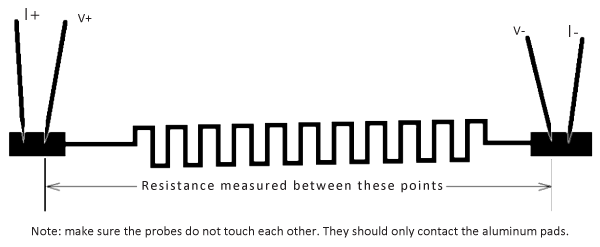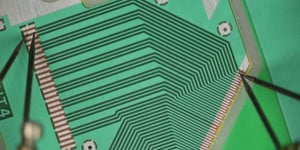Measuring resistance of a fine-line Aluminum Trace provides different challenges compared to traces on a Copper PCB, most importantly, the surface aluminum oxide is tenacious and it can be difficult to get through to arrive at an accurate and repeatable measurement.
We do not recommend using a 2-wire measurement
It is very difficult to obtain accurate two-wire resistance measurements because the line resistance will be overcome by the contact resistance. In fact, you should expect the dominant source of error to be contact resistance.
We recommend using a 4-wire measurement

The measured resistance is:

Calculating the resistance of a Fine-Line Aluminum Trace uses the standard calculation:

However, the resistivity value ρ of aluminum must be taken into account.
While this value is 28 nΩ·m for pure aluminum, the 3003-H18 alloy used in the manufacturing of low temperature aluminum circuit boards is 43 nΩ·m.
Assuming a line length of 2 cm, a width of 100μm and thickness of 40μm and resistivity of 43 nΩ·m, we can calculate:

To achieve a target resistance, you can design the line length as well as the line width (to determine our current capabilities, please refer to our Aluminum Trace Design Guide).
The line heights available include 30 μm or 40 μm aluminum with or without an additional 5 μm of under-plated copper if required to provide additional adhesion and thermal conductivity.

In the real world example above, the resistance was measured at ~1 ohm (unstable) with 2-wire method, and 0.202 ohms (stable) with 4-wire method.
Some of our Aluminum-Trace PCB customers cool their boards to below 400mK to exploit the superconducting ability of aluminum. At this low temperature, the electric resistance falls to zero and the aluminum conducts current perfectly.

